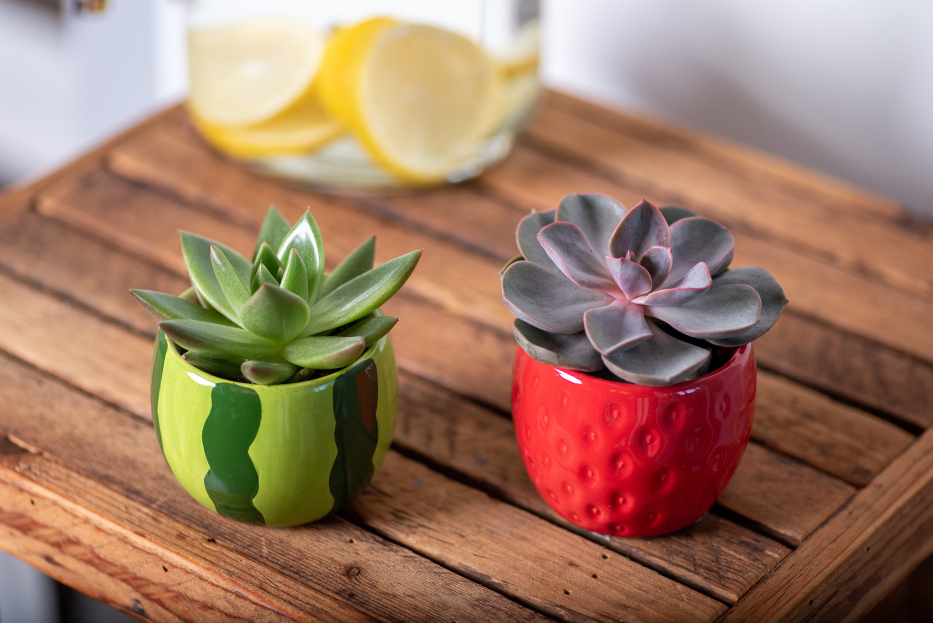
Whether you’re an experienced grower or new to plant-parenthood, easy-care succulents make a great addition to any collection!
Here are some answers to your most frequently asked succulent care questions.
“Succulents” are a group of plants that are specially adapted to living in areas of drought or arid regions. They are characterized by especially thick or fleshy leaves, stems, or roots that hold extra moisture, which helps them survive in extreme climates.
Cacti and succulents are similar, but different. The term “succulent” refers to a broad group of plants from different botanical families. Nearly all cacti are succulents but not all succulents are cacti.
Since succulents hold lots of water in their leaves, they do not need to be watered often. A good practice is to feel the soil, and only water your succulents when the soil feels thoroughly dry (about once every 2 to 4 weeks, depending on pot size, growth cycle and environmental conditions).
This is a tricky question with a lot of variables to consider. After watering, your succulent’s soil should feel moist, but there should not be any excess water standing in the bottom of its container. If you are allowing the excess water to drain away, you can be more generous. However, if your succulent is planted in a container that does not allow for drainage, be sure to water sparingly.
If your succulent comes in a decorative container that does not have a drainage plug or hole at the bottom, it is best to remove the plant temporarily (if possible) and water it in a sink or basin so that the excess water can drain out. Then put it back in its container. This will help prevent the roots from sitting in water for an extended period of time, which can cause root rot.
Bottom-watering succulents is also recommended because it helps promote healthy root growth. You can bottom-water your succulent by placing it in a sink, dish or basin that contains about an inch or so of water, and letting the plant sit and soak up water for about 5-15 minutes. Then you can return the plant to its container and put it back in a sunny place.
To give your succulents an extra boost, you can use a fertilizer formulated for cacti or succulents once per month during its active growth cycle. Alternatively, a balanced fertilizer formulated for indoor plants will suffice.
Most succulents are fine to repot about once every 1 to 2 years. Repotting is recommended when a plant gets too large for its existing pot (which can cause it to be root bound). Repotting helps your plant grow by giving it fresh soil with more nutrients.
Some signs that your succulent is ready to be repotted are: the plant has grown significantly; the roots appear tightly packed or can be seen coming out of the drainage holes of the grower pot; water does not absorb easily in the soil; or the soil dries out quickly and has pulled away from the sides of the pot.
When repotting your succulent, it is recommended to choose a pot that is slightly larger than your plant (about 0.5 inch between the plant and the pot). If your new pot does not have good drainage, it is helpful to add some small stones to the bottom to help keep the roots dry. A soil or potting mix that is specifically formulated for cacti or succulents is recommended, but you can also mix sand into regular potting soil to help with drainage.
“Dormancy” describes a period during which plant growth slows down. Think of it kind of like hibernation. Dormancy is usually triggered by extreme changes in temperature or drought. During this period of rest, succulents conserve their energy, minimizing growth until growing conditions are more ideal. Dormancy matters because dormant plants usually require less water and nutrients. It is also better to repot your plant at the beginning of its active growth cycle.
When it comes to dormancy, not all plants are the same. Some species of succulents are “summer dormant,” meaning they tend to go dormant during the hottest months of the summer, and experience most of their active growth during the winter months. Whereas other species are “winter dormant” and tend to grow more during the summer.
Some examples of winter-dormant (grow mostly in spring, summer & fall) succulent varieties are:
Some examples of summer-dormant (grow mostly in fall, winter & spring) succulent varieties are:
Succulents are opportunistic growers and don’t always follow these rules strictly. Succulents grown indoors may never achieve full dormancy like they would in the wild, because they aren’t subject to the same extremes. Some signs that your succulent is entering dormancy are: it stops producing new growth, it’s leaves appear limp, the rosette contracts, and/or its stems bend easily.
To test if your succulent is still alive but dormant, you can check the roots to make sure they appear healthy and not dry, shrivelled, or mushy. Alternatively, you can check using the “Snap-Scratch” test by scratching the stem lightly. If the insides are green and moist, the plant is alive.
Happy planting!